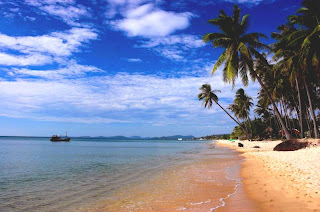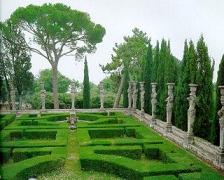Its growing popularity and developing hospitality might make it a runaway success, which at least one visitor hopes won't spoil its tropical perfection and laid-back atmosphere.

Reporting from Phu Quoc, Vietnam —
During the four years I lived in Hanoi, where I was The Times' bureau chief in the late 1990s, I did a pretty good job of getting around Vietnam and exploring new places, from Can Tho in the southern Mekong Delta to Sapa on the northern border with China. But I missed Phu Quoc, Vietnam's largest island. So did most people. Unless you were a backpacker looking for a cheap beach hotel, there wasn't much reason to go.
Fast forward to 2010. Phu Quoc, once known mainly for its pungent fish sauce and wartime history, is the hottest new tourist destination in Vietnam, a slice of tropical perfection with mile after mile of wide, uncrowded beaches, dense jungle, virgin rain forests and a lazy, laid-back atmosphere that reminds a visitor of what Phuket, Thailand, was like a generation ago.
Chuck Searcy, a former U.S. serviceman who lives in Vietnam and runs humanitarian programs, remembers his only visit to Phu Quoc about a dozen years ago. His plane circled the airport three times to scare cows off the runway, and the island had only three hotels, "all decidedly 'no star,' to put it kindly." Said Searcy: "I'm sure I wouldn't recognize the place today."
A few weeks ago, my wife, Sandy, and I hopped onto one of the nine daily turboprop flights Vietnam Airlines runs from Ho Chi Minh City (formerly Saigon) to Phu Quoc. No cows impeded our arrival. Our taxi took us through the dusty town of Duong Dong and down a dirt road lined with little patio restaurants; a cemetery, crammed between two bars; and a bamboo hut that served as a laundry. Although I had a moment of doubt, our driver insisted that just ahead lay La Veranda, Phu Quoc's first five-star resort.
The jungle parted, and we caught a glimpse of the Gulf of Thailand and Long Beach, which stretches for 12 miles. And in a waterside clearing lush with flowers and foliage stood La Veranda, a 48-room boutique hotel and spa with two restaurants. It seemed as though we had stumbled onto a French colonial plantation, its large louvered windows open to the sea, its deep balconies, high ceilings and overhead fans reminiscent of a bygone era.
That, in fact, is exactly what the owner, Catherine Gerbet, had in mind when she designed the hotel, now 4 years old. A French Vietnamese, she was born in Cambodia, raised in Hong Kong and lived in Saigon. Her goal was to build something that captured her childhood memories of Asia, and she didn't miss a touch. I wouldn't have blinked had I seen Graham Greene sipping a martini while sitting in one of the bar's wicker chairs.
I asked La Veranda's Swiss general manager, Nicolas Josi, what attracted foreigners to Phu Quoc and what they did when they got here.
"First, the island is just being discovered. It still feels authentic," Josi said. "You won't, for instance, find a building over two stories. A lot of our guests are tourists who have been hurrying about in Ho Chi Minh City and Hue and Hanoi. They take a break here to recharge their batteries. What they like to do here is often nothing, just relax."
Phu Quoc, a triangle-shaped island just 30 miles long, is closer to Cambodia than to the Vietnamese mainland. Settled in the 17th century by Vietnamese and Chinese farmers and fishermen, it was occupied in 1869 by French colonialists who built rubber and coconut plantations. The island was so remote for so long that when Saigon fell to Communist troops in April 1975, Phu Quoc's 10,000 people hardly seemed to notice and went quietly about their daily business, catching squid and tending their pepper vines.
But the island's isolation did not shelter it from war. Vietnam's largest prisoner-of-war camp was here, near the U.S. naval base at An Thoi on the southern tip of the island. Pol Pot's murderous Khmer Rouge guerrillas invaded and briefly occupied the island after Saigon's fall, and some of the non-Communist South Vietnamese forced out of the cities by Vietnam's harsh, new rulers were resettled here and told to become farmers.
"My parents were teachers. They didn't know how to grow turnips. We nearly starved," said Hoi Trinh, a Vietnamese Australian lawyer, who arrived here with his family in 1977 as a 7-year-old. To help support his family he sold watermelon seeds on Long Beach, not far from where La Veranda now stands. When he and his father were caught trying to flee by boat to Malaysia, young Trinh was sentenced to a month in Prison No. 7.
It was a full day before my wife and I emerged from La Veranda. We were massaged, fed, pampered at the swimming pool and on the beach by a locally recruited and trained staff whose eagerness to please and unfailing politeness more than compensated for its struggle with foreign languages. We checked out a trip to Ganh Dau on the northwest coast: Scuba diving, including transportation, lunch and equipment, was $80 for the day; snorkeling, $25. The water, we were told, was 88 degrees with a visibility of 30 feet. Instead we hired a taxi with a driver who spoke some English and set out to explore the island. The cost for three hours would be $30.
Scores of beachside bungalow-style hotels with open-air bars and restaurants were tucked unobtrusively among clusters of palms on the coastal road south. Some charged as little as $25 a night. French road markers along the way showed the distance to the next village. Hammocks, often occupied, hung in tree-shaded front yards. Peppercorns lay drying on faded blue tarpaulins, a reminder that Vietnam is among the world's largest exporters of pepper. Sometimes we caught a whiff of nuoc mam fish sauce, which the Vietnamese use to flavor almost every dish. We stopped at one of the many pearl farms, where a clerk showed us a $9,000 necklace. Happily, Sandy settled on a pair of $70 earrings.
The fishing boats had long since pulled out of An Thoi and other little ports, having left at dawn not to return until sunset, by the time we reached Coconut Prison. It was built by the colonialists in 1953, a year before Vietnam defeated France at Dien Bien Phu. The Americans and their South Vietnamese allies took over the 1,000-acre site in 1967, and for a time it held 40,000 North Vietnamese prisoners of war. More than 4,000 were said to have died there.
Guard towers still loom over rows of windowless tin POW barracks that are surrounded by coils of concertina wire. Except for an occasional tourist, the place was silent and empty. The small nearby museum (admission is 3,000 dong, about 16 cents) is not for the faint-hearted, with its scenes of torture depicted by chillingly real life-size mannequins.
The grimness of the place seemed incompatible with the tranquility of Phu Quoc, and leaves one thankful that Vietnam has known 35 years of peace. And what changes that peace has wrought. Less than three decades ago Vietnam had no tourist industry, and Vietnamese were forbidden to speak or socialize with foreigners.
Today, Vietnam attracts nearly 4 million tourists a year and luxury resorts — which numbered one when the five-star Furama opened on Da Nang's China Beach in the mid-1990s — reach up the coastline from Vung Tau, south of Ho Chi Minh City, to Thanh Hoa, near the former demilitarized zone.
With tourism creating jobs and spreading wealth, Phu Quoc's population has surged to 70,000, even though the northern part of the island, home to a large national park, is mostly uninhabited. Phu Quoc absorbs well the 50,000-plus visitors it draws annually, but changes are afoot.
The government has a master plan to develop Phu Quoc into a high-quality eco-tourism destination by 2020, when it aims to attract 2.3 million visitors a year. An international airport is scheduled to open in two years to accommodate nonstop flights from Japan, Thailand, Singapore and Hong Kong. Roads and bridges are being rebuilt and a deep-water port is being dug at An Thoi. Life may never be the same for an island that now uses generators to produce much of its electricity and gets its water from wells.
Driving north from An Thoi at sunset, watching the fishing boats return to port, we passed Duong Dong's night market, where $2 gets you a fresh seafood dinner, and got out of the taxi to walk on a deserted beach the last mile to La Veranda. Phu Quoc, I hoped that warm, star-lit night, would not lose its character in the tidal wave of coming development, because even by the toughest of standards, it's just about perfect as it is.
Source: Chicago Tribune
 The garden of Boboli is annexed to the complex of Pitti Palace and is one of the greatest parks in Florence (45,000 m2). The garden of Boboli constitutes one of the best existing examples of Italian garden in the XVI century.
The garden of Boboli is annexed to the complex of Pitti Palace and is one of the greatest parks in Florence (45,000 m2). The garden of Boboli constitutes one of the best existing examples of Italian garden in the XVI century.



























